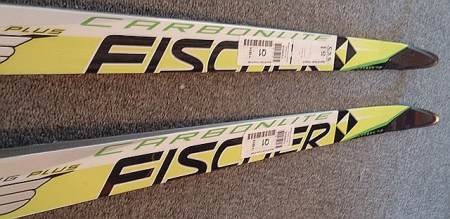
Fischer Carbonlite Field Test
Fri, Jan 12, 2007 - By Karl Saidla
This article first appeared on the excellent web site http://www.xcottawa.ca/ is reprinted by permission. Thanks XC Ottawa!
While there has certainly been some hype with the arrival of the Fischer RCS Carbonlite, I have yet to see a review from someone who has actually spent any significant amount of time skiing on them. While the skiing conditions in Ottawa have made it difficult for very much testing of new equipment, at this point I can say that I have spent enough time skiing with the Carbonlites, both skate and classic versions, to provide a brief review.
For a description of the differences in construction between the old RCS and the Carbonlite, you would be best advised to visit the engineeredtuning.net web site, specifically at http://www.engineeredtuning.net/Carbonlite.htm.
As I am not by any means on expert on ski construction, I will pretty much leave it at that. The one thing I will point out is that the Carbonlite is not simply the old ski with lots of carbon fibre in it. The construction is different, and, as far as I understand it, it is mainly due to a re-arranging of the honeycomb construction that the ski is made lighter.
Skate
I have only skied on the Plus version of this ski. While I understand that Cold skis are being made, I haven't actually even seen or tested any. While light skis are great, anyone who has done much skiing would tell you that the qualities of speed and responsiveness are clearly more important. The pair I have been using are plenty fast and responsive. As an indication, I have chosen my Carbonlite skis over my older regular RCS in every skate race or time trial that I have done this year. I chose them because they were faster, not because they were lighter. In the races themselves the skis performed exactly like I wanted them to. One pair is quickly becoming the pair I describe as my “regular favourites”. While I don't doubt that the old RCS skis are generally as fast and as responsive as the Carbonlites, my experience tells me that at the very least, the Carbonlites aren't giving anything away in terms of these aspects of performance.

One aspect where I think that the Carbonlite might represent an improvement over the old skis in what I will call “sensitivity”. It is my impression that I can feel what is going on underneath my feet in a slightly more precise way than I was able to before. I have no real comment on why that would be, but it is something I noted.
Now, on to the weight. The Carbonlites are noticeably lighter than the old skis (which, by the way, were not terribly heavy). I might describe the difference as something like using racing flats instead of training shoes for running, or climbing on your special tricked-out carbon road bike after putting in spring mileage on something less elegant. In other words, the weight difference is not likely to move you significantly up the results list, but it does feel nice. While skiing in flat and rolling terrain you notice that your shins don't have to work quite as hard to keep the tips off the ground. The weight reduction is most noticeable on steeper hills where you might want to employ a high-tempo offset. In this situation skiing is certainly easier and less awkward than before.
In sum, the Carbonlites that I tested have proven to be excellent. While the weight savings are noticeable, what is more important is that this has been accomplished without compromising other qualities of the ski.
Classic
Once again, I have only skied on the Plus version of these skis. In general, I have used them less than I have used the skate pair, mainly because the particular pair I have was picked for colder conditions than we have seen lately. I have, however, borrowed a pair picked for warmer weather on several occasions. My description, if I were to provide it in full, would largely be a re-hash of what I wrote about the skate skis. In terms of speed and the ability to provide sure grip, the skis are fantastic. I really liked the older Fischer classic skis in these aspects, and these are no different. I believe that it is safe to say that a well-picked Carbonlite is certainly the equal of a well picked old RCS.
The weight savings in classic are felt in slightly different circumstances. While doing diagonal stride the weight savings are felt while driving the ski forward. In classic skiing this is quite noticeable as you are moving the ski from what is essentially a stopped position. Even more noticeable is an uphill where you are running out of the track or herringboning. In regular diagonal stride, part of the weight of the ski is supported because some portion of the ski is always in contact with the track. As soon as you step out, however, you are forced to repeatedly lift the full weight of the ski and it is here that the real value of the weight savings is felt.
In summary, my experiences so far this year with both the skate and classic versions of the Fischer Carbonlite have been positive and would lead me to suggest that this will soon be widely considered a very successful product.
